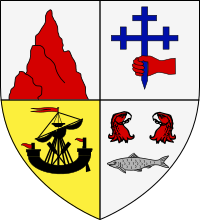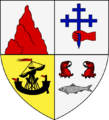Sir Hector Og Maclean, 15th Chief facts for kids
Quick facts for kids
Sir Hector Og MacLean of Duart, 15th Clan Chief
|
|
|---|---|
 |
|
| 15th Clan Chief 11th Laird of Duart |
|
| Preceded by | Lachlan Mor Maclean, 14th Chief, father |
| Succeeded by | Hector Mor Maclean of Dowart, 16th Clan Chief, son |
| Personal details | |
| Born |
Hector Og MacLean
1583 |
| Died | 1623 (age 40) |
| Spouses | Janet Mackenzie of Kintail Isabella Acheson of Gosford |
| Children | Hector Mor Maclean of Dowart, 16th Clan Chief Lachlan Maclean of Morvaren, 17th Clan Chief Donald MacLean, 1st Laird of Brolas Sir John Maclean, 1st Baronet |
| Parent | Sir Lachlan Mor Maclean |
| Residence | Duart Castle on the Isle of Mull |
Sir Hector Og Maclean (1583–1623), also known as Eachann Óg Maclean in Scottish Gaelic, was an important leader in Scotland. He became the 15th Clan Chief of Clan Maclean.
Contents
Early Life and Becoming Chief
Hector Og Maclean was born in 1583. His father was Sir Lachlan Mor Maclean, who was the 14th Clan Chief.
When Hector was twenty years old, his father was killed in the Battle of Traigh Ghruinneart. After this sad event, Hector became the new Chief of Clan Maclean. His very first action as chief was to get revenge on Clan MacDonald for his father's death.
The Battle of Benbigrie
In 1598, Hector got permission from the king to take action against the MacDonalds of Islay. He asked other clan leaders to help him. These included the Chief of the Clan Mackinnon, MacLeod of Dunvegan, and MacNeil of Barra.
The Chief of the Camerons of Lochiel also joined them. This large group of clans went to Islay. Sir James MacDonald, 9th of Dunnyveg, knew they were coming. He gathered all the fighters from Islay and Kintyre to prepare for a big battle.
The two sides met at a place called Benbigrie. Neither side wanted to back down, so a battle started right away. The MacLean forces had more fighters than the MacDonalds. But Sir James MacDonald told his men they had to fight hard. He said it was their only hope to protect themselves and their homes.
The MacDonalds fought with great anger. They kept fighting even as many of their men fell. Their chief, Sir James MacDonald, was badly wounded and had to be carried away. Finally, the MacDonalds were outnumbered and had to retreat. They ran in confusion, looking for safety. A few managed to take their wounded chief to Kintyre. Islay was left open to the attacking clans.
For three days, the allied clans caused a lot of damage across the island. Many homes were burned down. The people had to hide in caves and rocky places without food or shelter. The fighting stopped only when the destruction was complete.
During this time, the Chief of the Camerons of Lochiel captured Hector MacLean of Lochbuie, 9th Chief. This Hector MacLean had helped the MacDonalds against his own clan chief. He and some of his followers were held as prisoners for six months.
This battle was the last big fight between the MacLeans and the MacDonalds. After the Battle of Benbigrie, the two clans stopped their fighting. They began to live in peace and friendship.
Around 1599, James VI of Scotland needed more money for his kingdom. He looked to the Western Isles for this money. He decided that the clan chiefs should pay a lot of money to the crown. He appointed new leaders, Ludovic Stewart, 2nd Duke of Lennox and George Gordon, 1st Marquess of Huntly, to manage the Highlands and Islands. The king believed the islanders were not paying enough taxes and were causing trouble.
Losing His Lands
George Gordon, 1st Marquess of Huntly, who was in charge of the northern areas, called a meeting. Clan chiefs had to attend this meeting in Stirling, Scotland by a certain date. If they didn't show up, they would lose their lands.
Hector Og Maclean owned land in Lochaber. So, he quickly set off for Stirling. When he arrived, he met Huntly on the street early in the morning. Hector asked if he had time to change his clothes before his name was called at the meeting. Huntly said he had plenty of time.
However, when Hector went to change, he learned the meeting had already started. He rushed to the assembly. But when he got there, his name had already been called. Huntly had gone straight to the meeting after talking to Hector. He ordered Hector's name to be called right away. Since Hector wasn't there, Huntly immediately asked for his lands to be taken away. This was granted, and Huntly kept the land.
Hector tried everything he could to get his lands back. He asked the king for help. But Huntly always strongly opposed him. Huntly felt this was his revenge on Hector for something Hector's father, Sir Lachlan Mor Maclean, had done in the past. Hector Og Maclean died in 1623.
Family Life
Hector Og Maclean was married twice and had several children.
His first wife was Janet Mackenzie of Kintail. She was the second daughter of Colin Cam Mackenzie of Kintail. They had two sons:
- Hector Mor Maclean, 16th Clan Chief (born around 1600, died 1626). He was the oldest son and became the clan chief after his father.
- Sir Lachlan Maclean, 1st Baronet (born around 1600, died 1649). He became the 17th Clan Chief after his older brother died.
Hector's second wife was Isabella Acheson of Gosford. She was the daughter of Sir Archibald Acheson, 1st Baronet. They also had two sons:
- Donald MacLean, 1st Laird of Brolas (born around 1600, died after 1655). One of his descendants, Sir Allan Maclean, 6th Baronet, later became the 22nd Clan Chief.
- Sir John Maclean, 1st Baronet (1604-1666). He moved to Sweden and changed his name to John Hans Makeléer.
Images for kids


